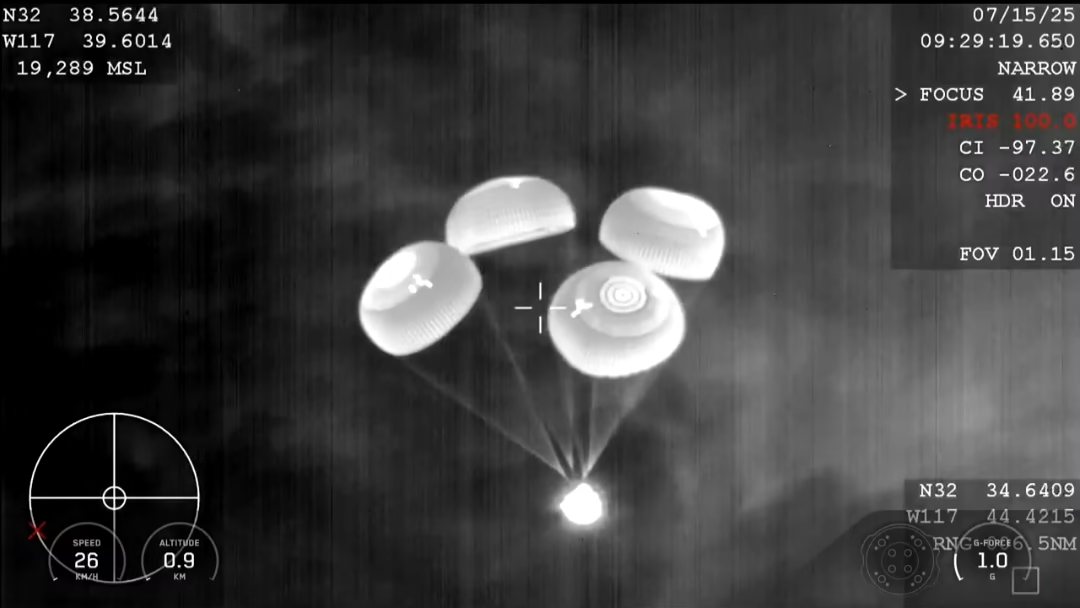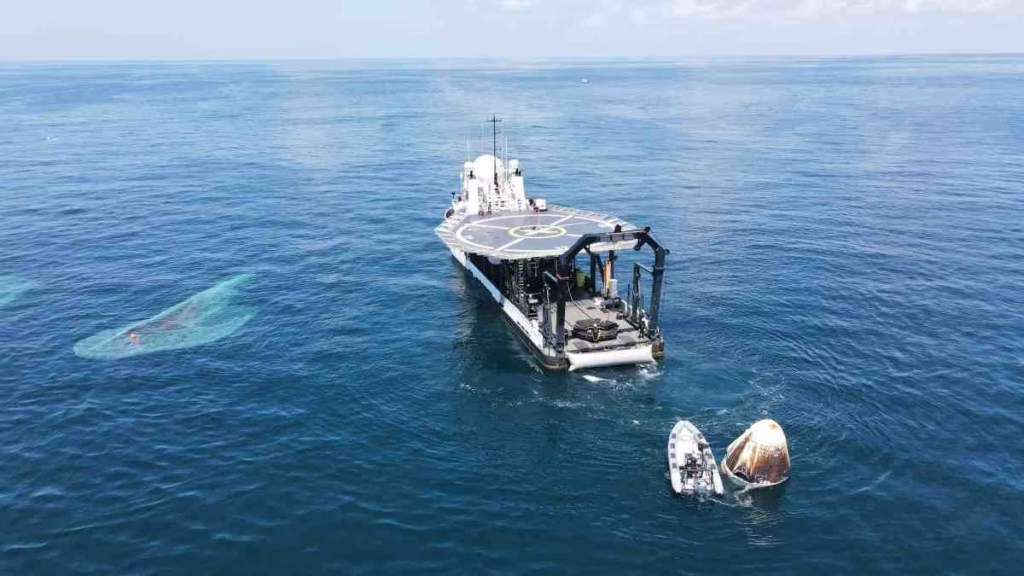Axiom-4 Splashdown safely at midnight, completing a historic journey for commercial astronauts aboard SpaceX’s Dragon spacecraft after their stay on the International Space Station.

Introduction: A Safe Return Under the Stars
In a triumphant conclusion to a mission that represents the future of commercial space travel, the Axiom Mission 4 (Ax-4) crew safely returned to Earth with a midnight splashdown in the Pacific Ocean. The four-person team, which spent over a week aboard the International Space Station (ISS), landed aboard SpaceX’s Dragon spacecraft under a canopy of parachutes and calm seas.
The successful re-entry and landing signify another leap forward in private human spaceflight, as Axiom Space continues to build the foundation for its commercial space ambitions.
Axiom-4 Splashdown Landing Details: Precision in the Dark
The Dragon spacecraft performed a flawless re-entry sequence, culminating in a safe ocean landing just after midnight IST (Indian Standard Time). The capsule descended gently into the waters off the coast of California, where SpaceX recovery teams, backed by Axiom Space and NASA support staff, were waiting on standby.
Key Landing Facts:
- Date: July 15
- Time: Around 12:00 AM IST
- Location: Pacific Ocean, off California coast
- Vehicle: SpaceX Dragon
- Recovery Ship: SpaceX’s dedicated vessel with recovery divers and medical crew
Despite the challenges associated with night-time operations, the recovery was executed efficiently and without incident, demonstrating the maturity of current commercial space infrastructure.
Axiom-4 Splashdown Mission Recap: Science, Outreach, and Operations
Launched earlier in July from NASA’s Kennedy Space Center in Florida, Ax-4 marked the fourth mission organized by Axiom Space to ferry private astronauts to the ISS in partnership with SpaceX and NASA. The four-member crew conducted numerous activities during their time in orbit, including:
- Scientific research in microgravity
- Public engagement and STEM education sessions
- Operational tests for commercial modules
- International collaboration with Expedition crew
Their stay aboard the ISS lasted more than a week, with each astronaut playing an active role in mission success.
Crew Composition: A Blend of Skills and Experience
While Axiom Space has not publicly disclosed all members’ names for this particular mission, previous flights have included a mix of:
- Veteran professional astronauts
- International partners from national space agencies
- Trained private citizens conducting research and outreach
Each astronaut underwent months of preparation, including simulations of launch, docking, station life, and emergency procedures. Onboard, the crew maintained a strict schedule that mirrored NASA’s Expedition standards.
Life in Orbit: Ax-4’s Onboard Activities
The Ax-4 crew’s daily schedule aboard the ISS included:
- Scientific Research: Including fluid behavior, plant growth, and human biology experiments
- Technology Demonstrations: Wearables, autonomous sensors, and material testing
- Media and Outreach: Live video events with schools, universities, and global audiences
- Maintenance Support: Assisting with routine ISS tasks and troubleshooting
These efforts contributed not just to the mission’s success, but also to ongoing experiments with real-world applications.
Undocking and Return Journey: Axiom-4 Splashdown
The journey home began with a scheduled undocking from the ISS’s Harmony module on July 14 at 4:30 PM IST. After separating from the station, Dragon completed multiple orbits around Earth, gradually lowering its altitude before initiating the deorbit burn.
Steps in Return Sequence:
- Trunk Separation – Jettisoning the unpressurized cargo section
- Deorbit Burn – Precision engine firing to slow the spacecraft
- Atmospheric Re-entry – Heat shield protected the capsule through extreme temperatures
- Parachute Deployment – Drogue chutes followed by four main parachutes
- Splashdown – Gentle descent into the Pacific Ocean
The capsule’s systems performed nominally throughout, and onboard life support ensured the crew remained safe and comfortable.
Recovery Operations: Night Landing Success Axiom-4 Splashdown
The night splashdown posed unique challenges, but SpaceX’s experienced recovery teams were well-prepared. The recovery vessel approached the capsule using searchlights and thermal imaging. Divers secured the spacecraft and hoisted it onto the recovery ship using a specialized hydraulic lift.
Once onboard:
- The capsule hatch was opened
- Medical teams conducted initial health assessments
- The astronauts exited one by one, waving to support teams
- The crew was flown by helicopter to a post-landing facility for detailed health checks and debriefing
Symbolism of a Midnight Axiom-4 Splashdown
Landing in darkness adds a dramatic layer to the Ax-4 story, symbolizing the quiet power and growing reliability of commercial space operations. Unlike early spaceflights that relied entirely on government-led missions and daylight recoveries, Ax-4’s midnight return proves that privately organized, round-the-clock missions are not only possible but increasingly routine.
Mission Objectives: What Ax-4 Achieved Axiom-4 Splashdown
The Ax-4 mission served several important purposes for the advancement of human spaceflight:
1. Commercial Research
Experiments conducted by the crew have applications in pharmaceuticals, agriculture, and wearable tech.
2. International Access
By inviting astronauts from outside the U.S., Axiom fosters global cooperation and opens doors for more nations to participate in space.
3. Private Space Training
Ax-4 refined procedures for training future commercial astronauts, paving the way for routine private travel to low Earth orbit.
4. Operational Testing
Data gathered will inform the development of Axiom’s future space station modules, set to launch by 2026.
The Future of Axiom Space: Axiom-4 Splashdown
With four missions successfully completed, Axiom Space continues to lead the commercial crew spaceflight industry. The company’s broader goals include:
- Launching the first commercial space station segment
- Creating a standalone orbital platform after ISS retirement
- Providing services such as tourism, research, and satellite hosting
Each mission, including Ax-4, helps build the operational experience and partnerships needed to reach these ambitious goals.
SpaceX’s Role and Dragon’s Reliability: Axiom-4 Splashdown
The Dragon capsule used for Ax-4 demonstrated once again why it is the most trusted commercial spacecraft currently in operation. With multiple crewed missions under its belt, Dragon provides:
- Autonomous docking and undocking
- Redundant safety systems
- Precision re-entry and parachute landing
- Reusability for future flights
SpaceX continues to improve the platform with every mission, ensuring higher reliability and lower costs for private and public clients.
NASA’s Support for Commercial Spaceflight: Axiom-4 Splashdown
While Ax-4 was a private mission, it was made possible through NASA’s Commercial Low Earth Orbit Development Program. NASA provided access to the ISS, technical guidance, and safety oversight.
By enabling missions like Ax-4, NASA reduces its own operating costs while encouraging innovation and competition in the space industry.
https://x.com/SpaceX/status/1945053906607771849?t=4Kkyop8sMZKEEWxVj64yJg&s=19
Global Reactions and Public Impact: Axiom-4 Splashdown
News of Ax-4’s safe landing quickly spread across international media and social platforms. Audiences from participating countries celebrated the success, highlighting the growing public interest in space beyond just national efforts.
Live coverage and educational broadcasts throughout the mission helped:
- Inspire students around the world
- Promote STEM education
- Showcase peaceful international cooperation in space
FAQs: Axiom-4 Splashdown
Q1: When did Axiom Mission 4 return to Earth?
A: The mission concluded with a safe splashdown just after midnight IST on July 15.
Q2: Where did the capsule land?
A: In the Pacific Ocean off the coast of California.
Q3: How long was the Ax-4 mission?
A: The mission lasted more than a week aboard the International Space Station.
Q4: What spacecraft was used?
A: SpaceX’s Dragon spacecraft was used for launch and return.
Q5: Was this a government mission?
A: No, it was a private mission organized by Axiom Space in partnership with NASA and SpaceX.
Q6: What were the main goals of Ax-4?
A: Scientific research, technology demonstrations, international collaboration, and private astronaut training.
Q7: What happens next for the astronauts?
A: They undergo medical evaluations and participate in debriefings before returning to their home countries or organizations.
Q8: Will there be more Axiom missions?
A: Yes, Axiom is already planning its fifth mission and continues building its own space station modules.
Q9: How does this benefit future space travel?
A: It demonstrates that commercial missions can be safe, effective, and repeatable, which supports the growth of the space economy.
Q10: What does this mean for space access?
A: Ax-4 shows that space is no longer reserved only for government astronauts—private individuals and international partners can now participate.
Axiom Mission 4 Prepares for Undocking—What Happens When They Return to Earth?


